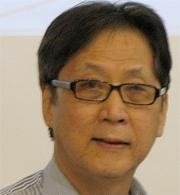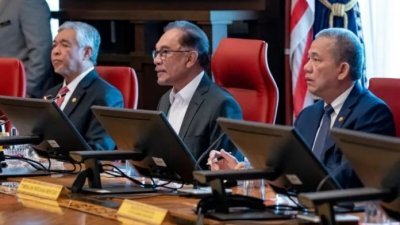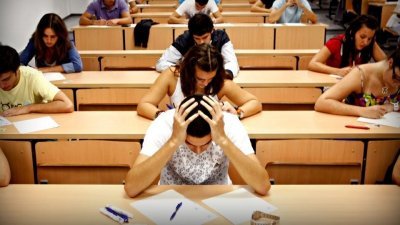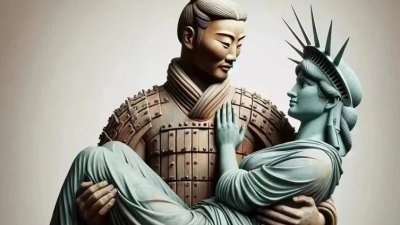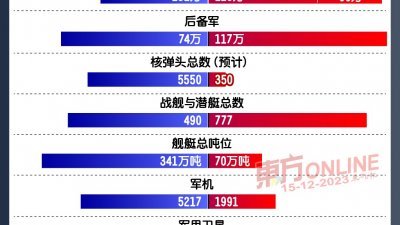一年的变化是如此之大!
仅仅一年前,乌克兰总统泽连斯基和西方领导人宣称俄罗斯在与乌克兰的战争中将落败。当时,俄罗斯在战场上遭遇挫折、伤亡惨重、军事混乱看似在迫使俄罗斯总统普京求和并撤出此次俄乌战争中所占领的克里米亚地区。
同时,西方的制裁,再加上其盟国——特别是亚洲的日本、韩国和新加坡的跟随,使得俄罗斯为战争付出了惨重的财务负担时,本土经济也不能幸免受到影响。另一方面,乌克兰则获得了外国前所未有的大量军事和非军事援助。这些援助估计至少达到2330亿美元/1.08兆令吉。
美国、北约和泽连斯基的预期是,俄罗斯终将惨败,进而导致俄罗斯政权更迭。当时的西方媒体不断宣称普京如果输掉这场他挑起的战争,其权位将不保。
西方更喜欢的场景是俄罗斯精英或军方发动反普京政变。进而使俄国政治出现危机,让没强烈民族主义色彩的新领导人崛起。俄乌战争中俄罗斯雇佣军,瓦格纳集团领导人普里戈任的事态发展,以及随后他与普京关系的恶化,以及飞机失事死亡,让人们对普京随时可能下台,抱持很大希望。
另一种情况则是俄罗斯领导人突然去世或在政变中被推翻。这将使俄罗斯陷入动荡,进而无法维持国内稳定和在乌克兰的军事行动。继任普京的任何新领导层,虽然仍是充满民族主义色彩和反西方的,但都不会那么致力于维持在乌克兰的战争,以及战争对俄罗斯经济和社会的负面影响。这种情况可能使俄罗斯军队撤军并透过谈判结束冲突。
这两种选择仍然摆在西方的台面上,然而如果没有周详策划和准备,这情况似乎不太可能发生。
美国和西方也正在使用类似的策略来分化中国。
俄乌立场
回到当下俄乌战争,实际情况又如何?普京和俄罗斯有可能投降吗?
首先,俄罗斯军事损失并没有如西方预期般严重。反之,之前大肆吹捧的乌克兰攻势并没有成功,乌克兰和西方内部更互相指责。乌克兰武装部队总司令扎卢日尼最近在一次广为人知的访谈中指出,战事陷入僵局。为此,他遭到泽连斯基斥责,并勒令不得参与非军事事务。
这反映不是俄罗斯领导层面临团结问题,而是乌克兰一方在战争战略上出现分裂和分歧。同时,泄漏的五角大楼文件显示了美国对战争状况的悲观看法。这些报告指出了乌克兰在武器和防空上的弱点,并预测未来几个月战争将陷入僵局。
也许,最重要的是,对战争厌倦的不仅是乌克兰方面。北约国家和美国的公众也对泽连斯基的支持率有所下滑,并且越来越多的人反对增加对乌克兰的军事和财政援助,因为这似乎也是一个腐败丛生且注定失败的计划。
在俄罗斯方面,普京显得比以往任何时候都更有自信。2023年6月时,普里戈任领导下的瓦格纳军团“兵变”的最初几天,西方媒体大肆宣扬普京实力被严重削弱,甚至这可能是致命的一击。但事实证明这只是西方一贯的宣传术。这也是西方和其亚洲盟国的媒体,用于对付中国国家主席习近平和其他不遵从美国路线的第三世界领导人的舆论战一部份。
最近,普京宣布打算在2024年大选中再次竞选总统,此举将使他至少执政到2030年。即将到来的3月选举对他来说似乎只是走个形式。普京不会面对强大竞争对手,即使有,普京也肯定会赢。2023年10月的最新民调显示,80%的俄罗斯人,即10俄罗斯人中有8人支持普京。其受欢迎程度比2022年9月还高出5%,9月时俄罗斯宣布“部分动员”令后,一度有所下滑。
俄人充满信心
值得注意的是,普京现年71岁,比美国总统大选的领跑者拜登或特朗普都年轻。无论美国那一方胜选总统,都须面对一个不可避免的事实:普京在位时间将比他们更久,并且得到绝大多数俄罗斯人的支持,俄国人对普京领导国家和开展的俄乌战争充满信心。
普京攻打乌克兰意图是什么?普京在年度新闻发布会上,面对著俄罗斯和外国的记者以及公众提出了各项问题,并一一做出了解答,这包括西方对俄罗斯的制裁、乌克兰和加沙冲突、莫斯科与美国及美国盟友的关系等,以及全球经济发展。
在乌克兰战争问题上,普京明确表示,除非俄罗斯达到其目标,否则不会有和平,而这目标依然保持不变。普京解释说,莫斯科要将“乌克兰去纳粹化和非军事化”以及成为“中立地位”,他明确告诉出席者和世界各国,一旦实现这些目标,和平才会到来。
如今回到了乌克兰、美国和北约决定下一步应该采取什么行动,以应对这位可能是过去百年来最受欢迎的俄罗斯政治领袖,其领导著一个在历史上面对著种种不利因素下,对战争依然有著持久力和耐力的国家。
林德宜《美国和西方能打倒普京与俄罗斯?》原文:Putin and Russia: Can the US and West Bring Them Down?
What a difference a year makes!
Barely a year ago Ukraine President Zelensky and leaders from the West were pronouncing the imminent defeat of Russia in its war with Ukraine. At that time, Russian setbacks in the battlefield, heavy casualties and military disarray were seen as forcing Russian President Putin to sue for peace and to withdraw from its occupation of the territories in the Crimea region which had provoked the decision to invade Ukraine.
Meanwhile, Western sanctions, supplemented by those of its allies - notably Japan, South Korea and Singapore in Asia - had made it costly for Russia to finance the war without hurting the Russian economy. Ukraine, on the other hand, was the recipient of an unprecedented bonanza of foreign assistance, both military and non military. This assistance was last estimated at US$233 billion
The United States, NATO and Zelensky expectation was that the humiliating defeat for Russia would lead to regime change in Russia. Western media at that time continually pushed the narrative that Putin would be unable to survive if he lost the war he had instigated.
The preferred Western scenario was for an anti Putin coup from either the Russian elite or the military. This would result in a domestic political crisis and the emergence of a less nationalistic new leader. Developments related to the leader of the Wagner group, Yevgeny Prigozhin, Russia’s para military private sector ally in fighting in Ukraine, and the subsequent deterioration in his relationship with Putin, and plane crash death gave high hope that this could happen at any time.
A related scenario was for the Russian leader to suddenly die or be toppled in a coup. Such a happening would leave Russia destabilised and unable to maintain domestic stability and military presence in Ukraine. Any new leadership that succeeded Putin, while still nationalistic and anti-Western, would be less committed to continuing war in Ukraine and the negative effects on Russian economy and society. This scenario could then result in a pull-back of the Russian military and a negotiated end to the conflict.
Both these options are still on the table for the West though they appear very unlikely to happen without clandestine preparation.
A similar US and Western strategy is being used in the attempt to carve up the China cake.
Current Positions of Ukraine and Russia
So what is the actual situation now in respect of the war and the likelihood of a Putin and Russian surrender?
Firstly, the prediction of a Russian military loss has not taken place. A much touted Ukrainian offensive has failed amidst finger pointing within the Ukraine and Western side as who is to be blamed. Zaluzhnyi, the highest rank Ukrainian military commander, in a much publicised interview, recently noted that a military stalemate had emerged in the war. For this, he was rebuked by Zelensky and ordered not to engage in non military affairs.
Instead of the Russian leadership facing problems of unity, it is the Ukraine side that is experiencing division and disagreement over war strategy. Meantime, leaked Pentagon documents provide a pessimistic US view of the state of the war. Highlighting weaknesses in Ukraine’s weaponry and air defences, the papers predict a stalemate in the war for months to come.
And perhaps, most important of all, it is not only the Ukraine side that is suffering from war fatigue. NATO countries and the US have seen a fall in public support for Zelensky and growing objection to increasing military and financial assistance to Ukraine for what also appears a corrupt ridden and lost cause.
From the Russian side, Putin has emerged more confident than ever. In the initial days after the disorder in the Wagner forces under Prigozhin in June 2023, Western media had played up the news that Putin had been severely, perhaps fatally, weakened. But that turned out to be Western spin.
This is part of the same Western and allied Asian media spin used against President Xi of China and other Third World leaders that do not toe the US line.
Recently Putin announced his intention to run for president again in the 2024 election, a move that will keep him in power until at least 2030. The coming March election appears a formality for him. There is no strong rival candidate and even if one shows up, Putin is certain to win. The latest polls in October 2023 show that 80 percent or eight out of ten Russians approve of their President. The popularity level was five percent higher than in September 2022, when the figure declined following the announcement of a partial mobilisation.
It should be noted that at age 71 years, Putin is younger than Biden or Trump, the frontrunner candidates for the coming US presidential election. Whoever wins on the American side will have to deal with the inescapable fact that Putin will remain in political power longer than them as well as is being sustained by the support of the great majority of Russians who have confidence in Putin’s leadership of the country and war against Ukraine.
What does Putin want in Ukraine? Answers to these were provided by Putin during his annual press conference, in which Russian and foreign journalists, as well as members of the public quizzed him on a wide range of subjects including Western sanctions against Russia, the Ukraine and Gaza conflicts, Moscow’s relations with the US and its allies, and global economic developments.
On Ukraine, he made it clear there would be no peace until Russia achieves its goals, which he insists remains unchanged. Explaining that Moscow seeks the “deNazification and demilitarisation of Ukraine” as well as “neutral status” for the country, he told his audience and the rest of the world that peace will come as soon as these goals are reached,
It is up to Ukraine, the US and NATO now to decide what should be their next move in response to this unambiguous stance from someone who is possibly the most popular Russian political leader in the last 100 years and who leads a nation with a historical record of endurance and stamina in wars despite the most adverse factors against it.
要看最快最熱資訊,請來Follow我們 《東方日報》WhatsApp Channel.

